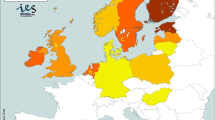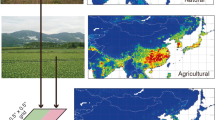Abstract
DayCent is a biogeochemical model of intermediate complexity widely used to simulate greenhouse gases (GHG), soil organic carbon and nutrients in crop, grassland, forest and savannah ecosystems. Although this model has been applied to a wide range of ecosystems, it is still typically parameterized through a traditional “trial and error” approach and has not been calibrated using statistical inverse modelling (i.e. algorithmic parameter estimation). The aim of this study is to establish and demonstrate a procedure for calibration of DayCent to improve estimation of GHG emissions. We coupled DayCent with the parameter estimation (PEST) software for inverse modelling. The PEST software can be used for calibration through regularized inversion as well as model sensitivity and uncertainty analysis. The DayCent model was analysed and calibrated using N2O flux data collected over 2 years at the Iowa State University Agronomy and Agricultural Engineering Research Farms, Boone, IA. Crop year 2003 data were used for model calibration and 2004 data were used for validation. The optimization of DayCent model parameters using PEST significantly reduced model residuals relative to the default DayCent parameter values. Parameter estimation improved the model performance by reducing the sum of weighted squared residual difference between measured and modelled outputs by up to 67 %. For the calibration period, simulation with the default model parameter values underestimated mean daily N2O flux by 98 %. After parameter estimation, the model underestimated the mean daily fluxes by 35 %. During the validation period, the calibrated model reduced sum of weighted squared residuals by 20 % relative to the default simulation. Sensitivity analysis performed provides important insights into the model structure providing guidance for model improvement.






Similar content being viewed by others
References
Abdalla, M., Jones, M., Yeluripati, J., Smith, P., Burke, J., & Williams, M. (2010). Testing DayCent and DNDC model simulations of N2O fluxes and assessing the impacts of climate change on the gas flux and biomass production from a humid pasture. Atmospheric Environment, 44, 2961–2970.
Del Grosso, S. J., Parton, W. J., Mosier, A. R., Hartman, M. D., Keough, C. A., Peterson, G. A., et al. (2001). Simulated effects of land use, soil texture, and precipitation on N gas emissions using DAYCENT. In R. F. Follett, R.F., & J. L. Hatfield (Eds.), Nitrogen in the environment: sources, problems, and management (pp. 413–431). the Netherlands: Elsevier.
Del Grosso, S. J., Mosier, A. R., Parton, W. J., & Ojima, D. S. (2005). DAYCENT model analysis of past and contemporary soil N2O and net greenhouse gas flux for major crops in the USA. Soil Tillage and Research, 83, 9–24.
Del Grosso, S. J., & Halvorson, A. D. (2008). Testing DAYCENT model simulations of corn yields and nitrous oxide emissions in irrigated tillage systems in Colorado. Journal of Environmental Quality, 37, 1383–1389.
Del Grosso, S. J., Ogle, S. M., Parton, W. J., & Breidt, F. J. (2010). Estimating uncertainty in N2O emissions from US cropland soils. Global Biogeochemical Cycles, 24, 1–12.
Del Grosso, S.J., Parton, W.J., Keough, C., Reyes-Fox, M.A. (2011). Special features of the DayCent modeling package and additional procedures for parameterization, calibration, validation, and applications. Soil Science Society of America Special Publication Book Chapter. pp. 155–176.
Doherty, J. (2010). PEST, model-independent parameter estimation—user manual. Brisbane: Watermark Numerical Computing.
Draper, N. and Smith, H. (1998). Applied Regression Analysis. Wiley, New York.
Gathany, M. A., & Burke, I. C. (2012). DAYCENT simulations to test the influence of fire regime and fire suppression on trace gas fluxes and nitrogen biogeochemistry of Colorado forests. Forests, 3, 506–527.
Grant, R. F., Nyborg, M., & Laidlaw, J. W. (1993). Evolution of nitrous-oxide from soil. 1. Model development. Soil Science, 156, 259–265.
Herzmann, D. (2004). IEM COOP data download. Available at http://mesonet.agron.iastate.edu/request/coop. Ames: Iowa Environment Mesonet, Department of Agronomy, Iowa State University.
Jarecki, M. K., Parkin, T. B., Chan, A. S. K., Hatfield, J. L., & Jones, R. (2008). Comparison of DAYCENT simulated and measured nitrous oxide emissions from a corn field. Journal of Environmental Quality, 37, 1685–1690.
Kohne, J. M., Kohne, S., & Simunek, J. (2006). Multi-process herbicide transport in structured soil columns: experiments and model analysis. Journal of Contaminant Hydrology, 85, 1–32.
Lamers, M., Ingwersen, J., & Streck, T. (2007). Modeling N2O emission from a forest upland soil: automatic calibration of Forest-DNDC model. Ecological Modeling, 205, 52–58.
Li, C., Aber, J., Stange, F., Butterbach-Bahl, K., & Papen, H. (2000). A process-oriented model of N2O and NO emissions from forest soils: 1. Model development. Journal of Geophysical Research, 105, 4369–4384.
Linn, D. M., & Doran, J. W. (1984). Effect of water-filled pore space on carbon dioxide and nitrous oxide production in tilled and nontilled soils. Soil Science Society of America Journal, 48, 1267–1272.
Loague, K., & Green, R. E. (1991). Statistical and graphical method for evaluating solute transport models: overview and application. Journal of Contaminant Hydrology, 7, 51–73.
Olander, L. P., & Haugen-Kozyra, K. (2011). Using biogeochemical process to models to quantify greenhouse gas mitigation from agricultural management projects: technical working group on agricultural greenhouse gases (T-AGG) supplemental report. USA: Duke University.
Parkin, T. B., & Kaspar, T. C. (2006). Nitrous oxide emissions from corn–soybean systems in the Midwest. Journal of Environmental Quality, 35, 1496–1506.
Parton, W. J., Hartman, M., Ojima, D., & Schimel, D. (1998). DAYCENT and its land surface submodel: description and testing. Global and Planetary Change, 19, 35–48.
Parton W. J., Holland E. A., Del Grosso S. J., Hartman M. D., Martin R. E., Mosier A. R., Ojima D.S., Schimel D. S. (2001). Generalized model for NOx and N2O emissions from soils. Journal of Geophysical Research 106(D15), 17403–17420.
Poeter, E. P., & Hill, M. C. (1999). UCODE, a computer code for universal inverse modeling. Computers and Geosciences, 25, 457–462.
Rafique, R., Hennessy, D., & Kiely, G. (2011a). Nitrous oxide emission from grassland under different management systems. Ecosystems, 14, 563–582.
Rafique, R., Mathias, P., Hennessy, D., & Kiely, G. (2011b). Evaluating management effects on nitrous oxide emissions from grasslands using process-based denitrification–decomposition (DNDC) model. Atmospheric environment, 45, 6029–6039.
Rafique, R., Anex, R., Hennessy, D., & Kiely, G. (2012). What are the impacts of grazing and cutting events on the N2O dynamics in humid temperate grassland? Geoderma, 181–182, 36–44.
Robertson, G. P., & Tiedje, J. M. (1987). Nitrous oxide sources in aerobic soils: nitrification, denitrification and other biological processes. Soil Biology and Biochemistry, 19, 187–193.
Spohrer, K., Jantschke, C., Herrmann, L., Engelhardt, M., Pinmanee, S., & Stahr, K. (2006). Lychee tree parameters for water balance modeling. Plant soil, 284, 59–72.
Stehfest, E. (2005). Modelling of global crop production and resulting N2O emissions, Univ. Diss., University of Kassel.
U.S. Department of Agriculture (USDA). (2011). U.S. Agriculture and Forestry Greenhouse Gas Inventory: 1990–2008. Climate Change Program Office, Office of the Chief Economist, U.S. Department of Agriculture, Technical Bulletin No. 1930.
U.S. Environmental Protection Agency (USEPA). (2011). Inventory of U.S. Greenhouse Gas Emissions and Sinks: 1990–2009. Office of Atmospheric Programs. EPA 430-R-11-005.
United Nations Framework Convention on Climate Change (UNFCCC). (2010). Offsetting of synthetic nitrogen fertilizers by inoculant application in legumes–grass rotations on acidic soils on existing cropland.
Wang, G. (2005). Agricultural drought in a future climate: results from 15 global climate models participating in the IPCC 4th assessment. Climate Dynamics, 25, 739–753.
Xing, H., Wang, E., Smith, C. J., Rolston, D. E., & Yu, Q. (2011). Modelling nitrous oxide and carbon dioxide emissions from soil in an incubation experiment. Geoderma, 167–168, 328–339.
Acknowledgments
This project is part of a regional collaborative supported by the USDA-NIFA, award no. 2011-68002-30190: Cropping systems Coordinated Agricultural Project: Climate Change, Mitigation, and Adaptation in Corn-based Cropping Systems. Special thanks to Cindy Keough, Keith Paustian, Bill Parton and Steve Del Grosso from Colorado State University for their help with DayCent modelling. We also would like to thank Jared Abodeely of the Idaho National Laboratory. We also would like to thank USGS’s reviewers for the thorough review process.
Author information
Authors and Affiliations
Corresponding author
Appendix
Appendix
Rights and permissions
About this article
Cite this article
Rafique, R., Fienen, M.N., Parkin, T.B. et al. Nitrous Oxide Emissions from Cropland: a Procedure for Calibrating the DayCent Biogeochemical Model Using Inverse Modelling. Water Air Soil Pollut 224, 1677 (2013). https://doi.org/10.1007/s11270-013-1677-z
Received:
Accepted:
Published:
DOI: https://doi.org/10.1007/s11270-013-1677-z




